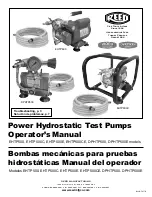
B-22
BOP-1K 080709
B.77 [SOURce:]LIST:VOLT:APPLy COMMAND
LIST:VOLT:APPL
Syntax:
Short Form: LIST:VOLT:APPL <type>,<value1>,<value2>[,<value3>]
Long Form: LIST:VOLTage:APPLy <type>,<value1>,<value2>[,<value3>]
Where <type> is {SQUARE | RAMP+ | RAMP- | TRIANGLE | SINE | LEVEL}
<value1> is frequency (or period (duration) for level)
<value2> is p-p amplitude (or amplitude (offset) for level)
<value3> is offset (optional, default is 0, not applicable to level)
Description:
Causes the unit to add a series of points to both the list:volt array and the list:dwell array to
make either a level or a waveform of one of five types.
Refer to table 3-11 for a description of the
waveform types. The waveform type specified is generated at the frequency specified with a peak-to-
peak amplitude centered on zero. If the optional offset value is specified, the center of the generated
series of points is moved off zero. The apply generator takes into account the soft limits for the voltage
channel and insures the generated array does not exceed the unit’s capabilities.
B.78 [SOURce:]LIST:VOLTage:APPLy:SWEep COMMAND
LIST:VOLT:APPL:SWE
Syntax:
Short Form: LIST:VOLT:APPL:SWE <>,
Long Form: LIST:VOLTage:APPLy:SWEep <value1>,<value2>
Where <value1> is start angle. Valid from 0 to 359.99 degrees.
<value2> is stop angle. Valid from 0.01 to 360.00 degrees
Description:
Allows the user to provide a starting angle for either triangle and sine waveforms and an
optional stop angle.
If the stop angle is not supplied, the unit defaults to 360 degrees. This command
should be placed at the beginning of the waveform program to be applicable to all sine and triangle
waveform segments.
B.79 [SOURce:]LIST:VOLTage:APPLy:SWEep? QUERY
LIST:VOLT:APPL:SWE?
Syntax:
Short Form: LIST:VOLT:APPL:SWE? Long Form: LIST:VOLTage:APPLy:SWEep?
Return Value: <value1>, <value2>(0.01 to 360)
Description:
Returns start
<value1>
and stop
<value2>
angle in degrees for either triangle and sine wave-
forms.
B.80 [SOURce:]LIST:VOLTage:POINts? QUERY
LIST:VOLT:POIN?
Syntax:
Short Form: LIST:VOLT:POIN? Long Form: LIST:VOLTage:POINts?
Return Value: <n> where n = number of points used
Description:
Identifies the total number of points in a list and the next location to be filled by LIST:VOLT
command.
The LIST:VOLT pointer is initially at 0 via LIST:CLE. For each data point entered by a
LIST:VOLT command the list pointer is incremented If LIST:VOLT:POIN? returns 5, the LIST:VOLT
pointer is at 5 indicating there are 5 data points comprising the list (locations 0 though 4) and location
5 is the next to be filled. If LIST:CURR has any entries, an error message: -221,"Settings conflict" is
posted in the error queue. Related Commands: LIST:VOLT. (See example, Figure B-5.)
B.81 [SOURce:]LIST:WAIT:HIGH COMMAND
LIST:WAIT:HIGH
Syntax:
Short Form: LIST:WAIT:HIGH value
Long Form: LIST:WAIT:HIGH value
where:
<value> = programmed current (Amps) for current list, or programmed voltage (Volts) for voltage list.
Description:
Waits for the trigger input to go high before advancing to next step.
When the command is exe-
cuted the output is immediately set to the <value>. Pins 1 (GND) and 3 of the Trigger Port are used as
the input trigger. If the trigger input is high (TTL logic 1 or open circuit) and a wait time has been estab-
lished by LIST:SET:WAIT, the step is immediately skipped. If the trigger input is low (TTL logic 0 or
short-circuit), the unit will proceed to the next step when either a) the trigger input goes high or b) the
wait time expires (non-zero wait values only), whichever comes first. If the wait time is 0, the unit must
wait until the trigger input goes high before proceeding to the next step.
In all cases, the trigger input must be high or low for at least 0.4 milliseconds to be considered stable.
This 0.4 millisecond delay provides a noise filter to insure only a level causes the output change.
This command must be preceded by LIST:CURR or LIST:VOLT command, otherwise a -221 “Settings
Conflict” error results. The entries of the dwell list must match the values in the current or voltage list,
otherwise a -226 “Lists Not Same Length” error results. (See Figures B-6 and B-7.)
Summary of Contents for BOP 1000W
Page 2: ......
Page 10: ......
Page 20: ......
Page 31: ......
Page 32: ......
Page 36: ......
Page 50: ...FIGURE 2 2 LOAD CONNECTIONS LOCAL SENSING...
Page 53: ......
Page 54: ......
Page 55: ......
Page 56: ......
Page 57: ......
Page 64: ......
Page 68: ...FIGURE 3 3 POWER UP SCREEN SHOWING GRAPHIC METERS VOLTAGE 0000 0...
Page 125: ......
Page 128: ......
















































